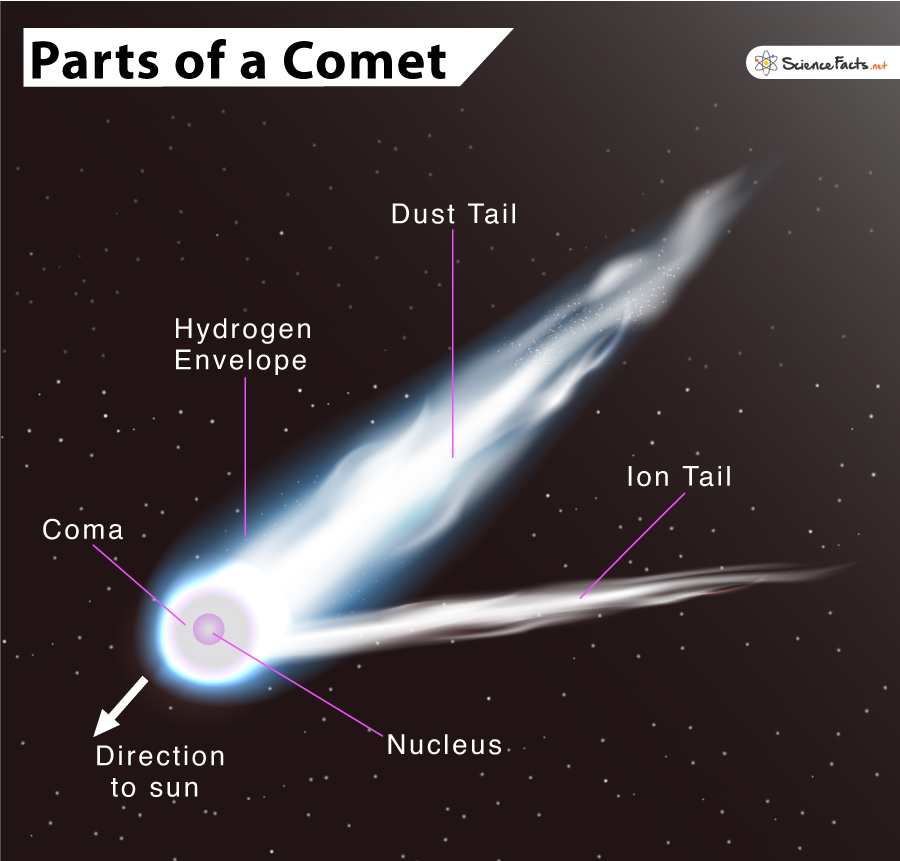
Unveiling the Mysteries of Comet Nuclei: Composition, Structure, and Cosmic Significance
Comets, often referred to as the “dirty snowballs” of the cosmos, are celestial objects that have captivated human curiosity for centuries. These enigmatic wanderers of the night sky hold secrets about the early solar system and the very building blocks of life. At the heart of every comet lies its nucleus, an intriguing and relatively small structure that serves as the cosmic time capsule. In this comprehensive article, we will explore the composition of a typical comet’s nucleus, delving into its unique attributes, origin, and the valuable insights it provides into the history of our solar system.
Comet Nuclei: The Cosmic Icebergs
Comet nuclei are the solid, central cores of comets, and they are often likened to icy space rocks. These nuclei, although relatively small compared to planets or moons, typically range in size from a few kilometers to tens of kilometers in diameter. Despite their modest dimensions, they are essential components of comets, as they contain pristine material dating back to the formation of our solar system over 4.6 billion years ago.
Composition of a Typical Comet’s Nucleus
A typical comet nucleus is composed of a complex mixture of volatile and refractory materials. These components provide a unique window into the history and conditions of the early solar system. Here’s an overview of the key constituents:
1. Water Ice (H₂O)
Water ice is the most abundant component of a comet nucleus. It can make up anywhere from 50% to 75% of the nucleus’s mass. This water is not only essential for the formation of cometary tails but also raises fascinating questions about the origin of Earth’s water. Some scientists believe that comets may have delivered a significant portion of Earth’s water through impacts in the distant past.
2. Dust and Silicates
Comet nuclei contain various types of dust and silicate materials. These grains are remnants of the primitive material from which the solar system formed. The dust particles often consist of tiny, micron-sized grains of minerals like olivine and pyroxene. Studying these grains can provide insights into the conditions and processes that led to the formation of the solar system.
3. Carbonaceous Compounds
Comet nuclei are rich in carbonaceous compounds, including organic molecules such as hydrocarbons, carbon monoxide (CO), and carbon dioxide (CO₂). These compounds are of particular interest because they contain carbon, one of the essential building blocks of life. Comets may have played a role in delivering organic molecules to the young Earth, potentially contributing to the origins of life.
4. Other Volatile Gases
In addition to water, comets contain other volatile gases like carbon monoxide, methane (CH₄), ammonia (NH₃), and hydrogen cyanide (HCN). These gases are released as the comet approaches the Sun and heats up, creating the characteristic coma and tails associated with comets.
5. Refractory Material
Comet nuclei also contain refractory, non-ice materials such as rocks and metals. These substances are often embedded within the icy matrix of the nucleus and can provide clues about the processes that occurred during the formation of the solar system.
Structure and Activity
Comet nuclei are not static objects; they undergo significant changes as they approach the Sun. As the nucleus heats up, ices sublimate (transform directly from a solid to a gas), creating a cloud of gas and dust known as the coma. The solar wind and radiation pressure from the Sun then push these materials away from the nucleus, forming the comet’s characteristic tails—typically a bright, white dust tail and a bluish gas tail.
Cosmic Significance and Exploration
Comets are often referred to as time capsules because they preserve the primitive, unaltered materials from the early solar system. Studying comet nuclei is essential for understanding the conditions, processes, and chemistry that prevailed during the formation of our solar system. Numerous space missions, including the European Space Agency’s Rosetta mission, NASA’s Stardust mission, and Japan’s Hayabusa2 mission, have visited or returned samples from comets, greatly advancing our understanding of these intriguing objects.
Conclusion
The composition of a typical comet’s nucleus is a fascinating blend of water ice, dust, organic compounds, and volatile gases. These ingredients offer valuable insights into the conditions and materials present during the formation of our solar system. The study of comets and their nuclei not only expands our knowledge of cosmic origins but also raises tantalizing questions about the role comets may have played in the emergence of life on Earth. As our understanding of these celestial wanderers continues to grow, so too does our appreciation for the celestial wonders that grace our night skies.
